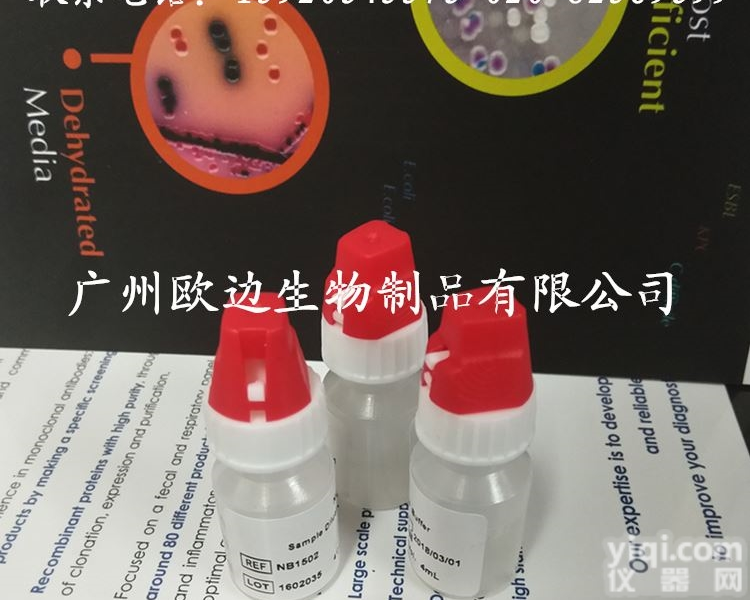
品牌 其他品牌 供货周期 现货
健仑代理Cellabs热带病诊断试剂盒
广州健仑生物科技有限公司
广州健仑长期供应各种生物原料,主要代理品Pai:美国Seracare、西班牙Certest、美国Fuller、美国NOVABIOS、 Cellabs等等。
Cellabs公司是一个ling先的生物技术公司,总部位于澳大利亚悉尼。专门研发与生产针对热带传染性疾病的免疫诊断试剂盒。其产品畅销40多个国家和地区。1998年,Cellabs收购TropBio公司,进一步巩固其在研制热带传染病、寄生虫诊断试剂方面的ling先位置。
健仑代理Cellabs热带病诊断试剂盒
该公司的Crypto/Giardia Cel IFA是国标*推荐的两虫检测IFA染色试剂、Crypto Cel Antibody Reagent是UK DWI水质安全评估检测的抗体。
主要产品包括:隐孢子虫诊断试剂,贾第虫诊断试剂,疟疾诊断试剂,衣原体检测试剂,丝虫诊断试剂,锥虫诊断试剂等。
广州健仑生物科技有限公司与cellabs达成代理协议,欢迎广大用户咨询订购。
我司还提供其它进口或国产试剂盒:登革热、疟疾、流感、A链球菌、合胞病毒、腮病毒、乙脑、寨卡、黄热病、基孔肯雅热、克锥虫病、违禁品滥用、肺炎球菌、军团菌、化妆品检测、食品安全检测等试剂盒以及日本生研细菌分型诊断血清、德国SiFin诊断血清、丹麦SSI诊断血清等产品。
欢迎咨询
欢迎咨询2042552662
【Seracare产品介绍】
货号 | 产品名称 | 产品描述 | 规格 | |
免疫荧光试剂盒(IFA kit) | ||||
KR1 | Crypto Cel | 隐孢子虫(Cryptosporidium)间接免疫荧光检测试剂 | 50 Test | |
KR2 | Crypto/Giardia Cel | 隐孢子虫&贾第虫(Cryptosporidium & Giardia)间接免疫荧光检测试剂 | 50 Test | |
KG1 | Giardia Cel | 贾第虫(Giardia)间接免疫荧光检测试剂 | 50 Test | |
KC1 | Chlamydia Cel | 沙眼衣原体(Chlamydia trachomatis)间接免疫荧光检测试剂 | 50 Test | |
KC2 | Chlamydia Cel LPS | 衣原体 lipopolysaccharide (LPS)间接免疫荧光检测试剂 | 50 Test | |
KC3 | Chlamydia Cel Pn | 肺炎衣原体(Chlamydia pneumoniae)间接免疫荧光检测试剂 | 50 Test | |
KP1 | Pneumo Cel | 卡氏肺孢子虫(Pneumocystis carinii)间接免疫荧光检测试剂 | 50 Test | |
KP2 | Pneumo Cel Indirect | 卡氏肺孢子虫( Pneumocystis carinii)间接免疫荧光检测试剂 | 50 Test | |
酶免试剂盒 ELISA kit | ||||
KG2 | Giardia CELISA | 贾第虫(Giardia)ELISA kit | 96 Test | |
KE1 | Entamoeba CELISA Path | 溶组织内阿米巴(Entamoeba histolytica) ELISA kit | 96 Test | |
KF1 & KF2 | Filariasis CELISA | 班氏丝虫(Wuchereria bancrofti ) ELISA kit |
| |
KM2 | Malaria Antigen (HRP2) CELISA | 恶性疟原虫(Plasmodium falciparum) 抗原 ELISA kit | 192 Test | |
KMC3 | Pan Malaria Antibody CELISA | 间日、三日、恶性及卵形疟疾(Malaria)ELISA IgG kit | 192 Test | |
KT2 | T. cruzi IgG CELISA | 克氏锥虫(Trypanosoma cruzi) ELISA IgG kit | 192 Test | |
KT3 | Toxocara IgG CELISA | 弓首线虫(Toxocara canis) ELISA IgG kit | 192 Test | |
KF3 | Filariasis Ab (Bm14) CELISA | 淋巴丝虫病(lymphatic filariasis) ELISA IgG kit | 480 Test | |
KM7 | Quantimal™ pLDH Malaria CELISA | 疟疾pLDH抗体检测 ELISA kit | 96 Test | |
二维码扫一扫
【公司名称】 广州健仑生物科技有限公司
【】 杨永汉
【】
【腾讯 】 2042552662
【公司地址】 广州清华科技园创新基地番禺石楼镇创启路63号二期2幢101-3室
【企业文化】



[What is a neglected tropical disease]
Neglected tropical diseases* are mainly epidemics that are endemic in hot and humid climates in poor areas, especially in the tropics. Most of them are parasitic diseases transmitted by insects such as mosquitoes, black flies, ferrets, tsetse flies, carnivora, and house flies, as well as snails. Some of the diseases are transmitted from soil contaminated with water and eggs. Environmental pollution has worsened the chain of transmission, and poor living and sanitary conditions have in turn aggravated environmental pollution. These diseases were once prevalent and now they are concentrated in extremely poor conditions. In other parts of the world, they have gradually disappeared as life and sanitation conditions have improved.
The neglected tropical diseases are not listed one by one here. There are also differences in different regions and countries. The disease that WHO is currently focusing on is: “Measures have been prepared for diseases” that can be treated with the use of therapeutic tools, including soil-borne helminth infections, lymphatic filariasis, onchocerciasis, schistosomiasis, and corn fields. Nematodiasis, zoonotic helminthiasis, dengue fever/dengue haemorrhagic fever, rabies, and IELTS; “measures lacking disease” that require treatment for specific diseases, leishmaniasis, African human trypanosomiasis, the Americas Trypanosomiasis and Brucella ulcers.
Why are they classified as a class
The organization has classified the neglected tropical diseases for the following two reasons. First of all, although all these diseases have different causes and physiological effects, they all cause severe disability and lifelong inconvenience. Second, these diseases and poverty are inextricably linked and the geographic regions affected are overlapping. In areas where epidemics are concentrated, there is often a lack of safe drinking water, or lack of access to water to protect personal hygiene, poor sanitation, poor housing, and mosquitoes that spread disease.
In addition, because many people suffer from multiple diseases at the same time, treating these diseases as a group of diseases is important for control planning.
The effects of neglected tropical diseases
Disease permanently affects human potential, making it difficult for over a billion poor people to escape poverty. They also impose an extremely heavy economic burden on the endemic countries.
Some of these diseases have greatly affected the economic productivity of young adults. Some diseases hinder children's development and inlectual development. All these diseases make patients tortured and often lead to social stigma and discrimination. Most diseases are blinded or crippled, resulting in appearance damage or incomplete limbs. They have a recessive incubation period, and patients often develop symptoms and are severely impaired after almost no symptoms of infection, missing the opportunity for medical treatment. During this period, parasites multiply in the body and accumulate in the tissues, guts, eyes, or lymphatic system after maturation. Some parasites destroy skin and subcutaneous tissue. If it is discovered and treated in time, it will cause irreversible damage. There are still some neglected tropical diseases that can cause death in weeks or months after they enter the late stage. 】
Neglected tropical diseases* are mainly epidemics that are endemic in hot and humid climates in poor areas, especially in the tropics. Most of them are parasitic diseases transmitted by insects such as mosquitoes, black flies, ferrets, tsetse flies, carnivora, and house flies, as well as snails. Some of the diseases are transmitted from soil contaminated with water and eggs. Environmental pollution has worsened the chain of transmission, and poor living and sanitary conditions have in turn aggravated environmental pollution. These diseases were once prevalent and now they are concentrated in extremely poor conditions. In other parts of the world, they have gradually disappeared as life and sanitation conditions have improved.
The neglected tropical diseases are not listed one by one here. There are also differences in different regions and countries. The disease that WHO is currently focusing on is: “Measures have been prepared for diseases” that can be treated with the use of therapeutic tools, including soil-borne helminth infections, lymphatic filariasis, onchocerciasis, schistosomiasis, and corn fields. Nematodiasis, zoonotic helminthiasis, dengue fever/dengue haemorrhagic fever, rabies, and IELTS; “measures lacking disease” that require treatment for specific diseases, leishmaniasis, African human trypanosomiasis, the Americas Trypanosomiasis and Brucella ulcers.
Why are they classified as a class
The organization has classified the neglected tropical diseases for the following two reasons. First of all, although all these diseases have different causes and physiological effects, they all cause severe disability and lifelong inconvenience. Second, these diseases and poverty are inextricably linked and the geographic regions affected are overlapping. In areas where epidemics are concentrated, there is often a lack of safe drinking water, or lack of access to water to protect personal hygiene, poor sanitation, poor housing, and mosquitoes that spread disease.
In addition, because many people suffer from multiple diseases at the same time, treating these diseases as a group of diseases is important for control planning.
The effects of neglected tropical diseases
Disease permanently affects human potential, making it difficult for over a billion poor people to escape poverty. They also impose an extremely heavy economic burden on the endemic countries.
Some of these diseases have greatly affected the economic productivity of young adults. Some diseases hinder children's development and inlectual development. All these diseases make patients tortured and often lead to social stigma and discrimination. Most diseases are blinded or crippled, resulting in appearance damage or incomplete limbs. They have a recessive incubation period, and patients often develop symptoms and are severely impaired after almost no symptoms of infection, missing the opportunity for medical treatment. During this period, parasites multiply in the body and accumulate in the tissues, guts, eyes, or lymphatic system after maturation. Some parasites destroy skin and subcutaneous tissue. If it is discovered and treated in time, it will cause irreversible damage. There are still some neglected tropical diseases that can cause death in weeks or months after they enter the late stage.
本产品信息由(广州欧边生物制品有限公司)为您提供,内容包括(进口试剂盒 健仑代理Cellabs热带病诊断试剂盒)的品牌、型号、技术参数、详细介绍等;如果您想了解更多关于(进口试剂盒 健仑代理Cellabs热带病诊断试剂盒)的信息,请直接联系供应商,给供应商留言。若当前页面内容侵犯到您的权益,请及时告知我们,我们将马上修改或删除。

关注微信公众号

微信小程序

![[酶联免疫<em>试剂盒</em>] 猪ELISA<em>试剂盒</em> 猪瘟(CSF)ELISA<em>诊断试剂</em>盒](https://item.yiqi.com/pic/CovPic/1/20108411021175.jpg)











